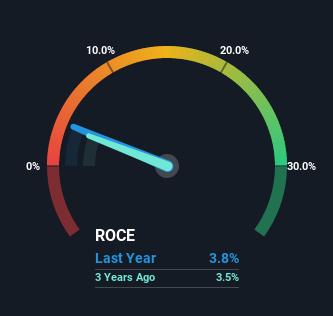- United States
- /
- Electric Utilities
- /
- NYSE:HE
Returns At Hawaiian Electric Industries (NYSE:HE) Appear To Be Weighed Down
What are the early trends we should look for to identify a stock that could multiply in value over the long term? One common approach is to try and find a company with returns on capital employed (ROCE) that are increasing, in conjunction with a growing amount of capital employed. Basically this means that a company has profitable initiatives that it can continue to reinvest in, which is a trait of a compounding machine. In light of that, when we looked at Hawaiian Electric Industries (NYSE:HE) and its ROCE trend, we weren't exactly thrilled.
Understanding Return On Capital Employed (ROCE)
Just to clarify if you're unsure, ROCE is a metric for evaluating how much pre-tax income (in percentage terms) a company earns on the capital invested in its business. Analysts use this formula to calculate it for Hawaiian Electric Industries:
Return on Capital Employed = Earnings Before Interest and Tax (EBIT) ÷ (Total Assets - Current Liabilities)
0.038 = US$385m ÷ (US$16b - US$6.1b) (Based on the trailing twelve months to December 2022).
Thus, Hawaiian Electric Industries has an ROCE of 3.8%. In absolute terms, that's a low return but it's around the Electric Utilities industry average of 4.7%.
Check out our latest analysis for Hawaiian Electric Industries

In the above chart we have measured Hawaiian Electric Industries' prior ROCE against its prior performance, but the future is arguably more important. If you'd like, you can check out the forecasts from the analysts covering Hawaiian Electric Industries here for free.
So How Is Hawaiian Electric Industries' ROCE Trending?
Things have been pretty stable at Hawaiian Electric Industries, with its capital employed and returns on that capital staying somewhat the same for the last five years. It's not uncommon to see this when looking at a mature and stable business that isn't re-investing its earnings because it has likely passed that phase of the business cycle. With that in mind, unless investment picks up again in the future, we wouldn't expect Hawaiian Electric Industries to be a multi-bagger going forward. On top of that you'll notice that Hawaiian Electric Industries has been paying out a large portion (61%) of earnings in the form of dividends to shareholders. These mature businesses typically have reliable earnings and not many places to reinvest them, so the next best option is to put the earnings into shareholders pockets.
What We Can Learn From Hawaiian Electric Industries' ROCE
We can conclude that in regards to Hawaiian Electric Industries' returns on capital employed and the trends, there isn't much change to report on. Unsurprisingly, the stock has only gained 33% over the last five years, which potentially indicates that investors are accounting for this going forward. Therefore, if you're looking for a multi-bagger, we'd propose looking at other options.
One final note, you should learn about the 3 warning signs we've spotted with Hawaiian Electric Industries (including 1 which is a bit unpleasant) .
If you want to search for solid companies with great earnings, check out this free list of companies with good balance sheets and impressive returns on equity.
Valuation is complex, but we're here to simplify it.
Discover if Hawaiian Electric Industries might be undervalued or overvalued with our detailed analysis, featuring fair value estimates, potential risks, dividends, insider trades, and its financial condition.
Access Free AnalysisHave feedback on this article? Concerned about the content? Get in touch with us directly. Alternatively, email editorial-team (at) simplywallst.com.
This article by Simply Wall St is general in nature. We provide commentary based on historical data and analyst forecasts only using an unbiased methodology and our articles are not intended to be financial advice. It does not constitute a recommendation to buy or sell any stock, and does not take account of your objectives, or your financial situation. We aim to bring you long-term focused analysis driven by fundamental data. Note that our analysis may not factor in the latest price-sensitive company announcements or qualitative material. Simply Wall St has no position in any stocks mentioned.
About NYSE:HE
Hawaiian Electric Industries
Engages in the electric utility business in the United States.
Fair value with questionable track record.
Similar Companies
Market Insights
Community Narratives


Recently Updated Narratives


MINISO's fair value is projected at 26.69 with an anticipated PE ratio shift of 20x


The Quiet Giant That Became AI’s Power Grid


Nova Ljubljanska Banka d.d will expect a 11.2% revenue boost driving future growth
Popular Narratives


The company that turned a verb into a global necessity and basically runs the modern internet, digital ads, smartphones, maps, and AI.


MicroVision will explode future revenue by 380.37% with a vision towards success



